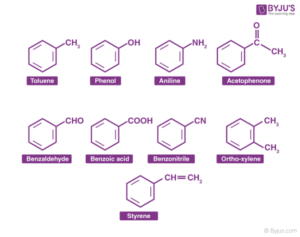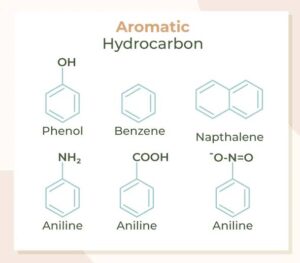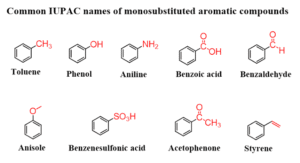Back to: Organic Chemistry 100 Level
Welcome to class!
Hello bright star! It’s always a pleasure to learn with you. You’re doing so well, and every step you take brings you closer to mastering Organic Chemistry. Today, we’re going to talk about something quite special and common in our everyday world—Aromatic Compounds. Don’t worry about the big word. I’ll break it down for you in a way that feels natural, relatable, and easy to understand. Let’s jump right in!
Aromatic Compounds
What Are Aromatic Compounds?
Have you ever walked into your mum’s kitchen while she’s cooking something spicy and sweet-smelling like jollof rice or egusi soup? That nice, strong smell is what people used to think aromatic compounds were all about—pleasant smell. But in Chemistry, aromatic compounds are not just about smell. They’re actually a special group of unsaturated compounds that have a ring structure and something even more special called delocalised electrons.

The most well-known aromatic compound is benzene. It’s the “king” of aromatic compounds, and it forms the foundation for many other ones.
Understanding Benzene
Benzene is made up of six carbon atoms arranged in a ring, with alternating single and double bonds. But here’s the twist: those double bonds are not fixed in one place. Instead, the electrons are shared equally around the ring, making the structure very stable. We call this delocalisation.
This makes benzene and other aromatic compounds very different from regular alkenes, even though both have double bonds. While alkenes react easily, benzene is more stable and reacts slowly.
Characteristics of Aromatic Compounds
Here are some key features that make aromatic compounds unique:
They have a cyclic (ring) structure, usually with six carbon atoms.
They have alternating double and single bonds, but the electrons are delocalised, meaning they move freely around the ring.
They obey something called Hückel’s Rule: which says aromatic compounds must have 4n + 2 π electrons, where “n” is a whole number.
They are usually stable and less reactive than other unsaturated compounds.
Examples of Aromatic Compounds
Apart from benzene, there are other aromatic compounds like:

Toluene – has a methyl group attached to a benzene ring.
Phenol – has an OH group attached to a benzene ring.
Aniline – has an NH₂ group attached.
These compounds are used in the production of dyes, plastics, perfumes, medicines, and even explosives. Yes, that’s how powerful and important they are!
Real-Life Uses of Aromatic Compounds
In Nigeria and around the world, aromatic compounds are part of our daily lives:
Benzene is used to make plastics, detergents, and drugs.
Toluene is found in paints and nail polish remover.
Phenol is used to make disinfectants (like Dettol).
Aniline is used in making rubber and dyes for textiles.

So the next time you see someone painting a house, using perfume, or wearing a brightly coloured ankara cloth, remember that aromatic compounds helped make it happen!
Summary
- Aromatic compounds are unsaturated hydrocarbons with special ring structures and delocalised electrons.
- Benzene is the most common aromatic compound.
- These compounds are very stable due to delocalisation.
- Aromatic compounds are used in making perfumes, plastics, paints, medicines, and many everyday products.
Evaluation
- What is the most common example of an aromatic compound?
- Why is benzene more stable than alkenes?
- What does it mean for electrons to be delocalised?
- Mention three real-life uses of aromatic compounds.
- Name one aromatic compound that contains an OH group.
You did great today! Understanding aromatic compounds puts you way ahead in Organic Chemistry. These tiny ring-shaped molecules do big things in our world, and now you know how they work! With Afrilearn, you’re not just learning—you’re becoming unstoppable. Keep up the amazing work, and I’ll see you in the next class. You’ve got this!
